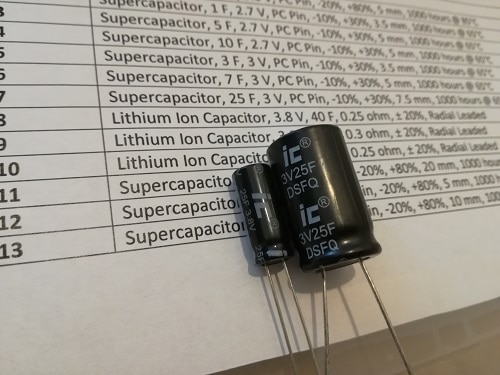Unboxing
My challenger's kit arrived at 09.VIII.2023 after brief stop at custom's office (almost all the paper work is done by Element14 staff, challenger is only responsible of filling in package contents description for custom's purposes).
Package was adequately protected from damage, but sealed in somewhat improvised way - it was probably opened at the border and sealed again by means more quick than sturdy - fortunately the contents were intact.
| {gallery}Unboxing |
|---|
|
|
|
|
|
|
|
|
Inside the drawer there was neat legend with part numbers corresponding to individual compartments:

and compartments were marked with numbers to not allow for any confusion

As others have observed, there was one part missing from the kit - 0.5W photovoltaic panel. As it turned out, it was sent in separate package that arrived only yesterday. This time there was no custom's office interaction and there were no signs of inspection. Package was smaller, Newark branded and marked with "supercaps" mark:

and contained one item - missing PV panel:

Capacitor types and families
Our kit contains capacitors from different families offered by our sponsor - Cornell Dubilier, kindly provided by Element14 in pairs of each part number (that can allow for parameter difference estimation between individual parts and/or building higher voltage circuits). It contains:
- from DGH family (standard voltage - 2.7V, high current family) - 1F, 5F and 10F capacitors,
- from DSF family (increased voltage - 3V, high current family) - 3F, 7F and 25F capacitors,
- from EDC family (high voltage, low working current, low leakage memory backup family) - 0.47F and 1F capacitors,
- from EDS family (high voltage, low working current, low leakage memory backup family) - 0.22F/3.6V and 0.1F/5.5V capacitors,
- from VMF family (LIC hybrid supercapacitor family, high temperature tolerant) - 25F and 40F hybrid supercapacitors,
- from VPF family (LIC hybrid supercapacitor family, designed for work from -25 deg. C, but with somewhat limited lifetime) - 40F hybrid supercapacitors,
It is worth noting that when other manufacturers offer capacitors rated at 2.3V-2.5V (standard) and 2.7V (high voltage), CDE managed to increase this voltage to 2.7V/3V and probably to 3.6V for low current models (if EDS224Z3R6H turns out to be single capacitor and not series connected pair).
Some of our capacitors are in fact supercapacitor batteries (as scottiebabe has shown at the challenge's forum some time ago) - pair of series connected capacitors, allowing for higher working voltage. This setup - it seems that without any balancing circuits, counting only on individual parts tolerances, is manufactured for years and seems to work good - below there is comparison with (about 20 years old) Panasonic Goldcap, that I have salvaged from old Intel server motherboard and which is in working condition despite old age.

There are two things worth noting - size difference (they are both 1F/5.5V parts) which indicate manufacturing process improvement and observable thinning in the middle of the cell, indicating point of connection between individual supercapacitors.
Another thing worth noting is volume difference between standard and hybrid supercapacitors - below we can see two 25F parts. Smaller size of LIC indicates higher energy density.

(Bad state of) hybrid capacitors
As Gough Lui already discovered, LIC capacitors are shipped charged and can be damaged by discharging below minimum working voltage. Some participants reported that most of their hybrid supercapacitors arrived badly discharged. Voltages of mine were as below:
| Model | Specimen | Voltage |
| VMF406M3R8 | 8/1 | 3.54V |
| VMF406M3R8 | 8/2 | 2.81V |
| VMF256M3R8 | 9/1 | 0.07V |
| VMF256M3R8 | 9/2 | 0.27V |
| VPF406M3R8 | 10/1 | 2.12V |
| VPF406M3R8 | 10/2 | 1.70V |
so - two were really badly discharged, and one was clearly under limit.
First thing I have done was short-circuit prevention using some packaging foam:

then revival was attempted.
Revival attempt
Two of my the hybrid supercapacitors were considered fully depleted (0.27V and 0.07V) at the arrival and one was below minimum allowed voltage (1.7V). Instead of throwing them away, revival was attempted. To charge them in controlled manner CC/CV power supply was used - shown below cheap switching converter module set to 3V voltage and 200mA current limit:

There was no explosion or detectable electrolyte leak, mostly depleted capacitor got only slightly warm to the touch during charging, maximum allowed current (indicated by overcurrent LED activation) was drawn for at most several seconds and it seems that they are (after four days of observation) keeping voltage above minimum - further measurements are ongoing.
That's all for my unboxing blog, next parts are being prepared.





